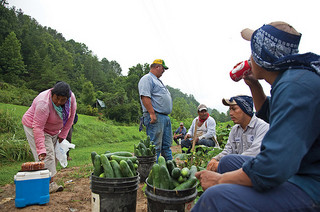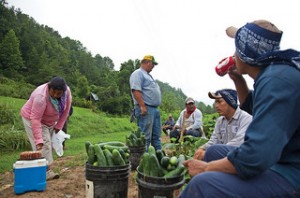Crops Rot due to Lack of Workers, Farmers Talk of Immigration Reformm

 By Aurora Almendral, Feet in 2 Worlds
By Aurora Almendral, Feet in 2 Worlds
Across the US, farmers have been complaining about labor shortages caused by a lack of migrant workers. In California, farmers are reporting a 20 percent drop in the labor force because of increased border patrols and a guest worker program that is not keeping up with the demand for farm labor.
California is a large agricultural state, and everything from fruits and nuts, to wine grapes and berries are being left to rot on vines and trees. In Washington state, apples are left unpicked, part of an estimated 10 percent of the state’s crops that have been abandoned, a result of what Time called “a complex web of local and state anti-immigration laws.”
 To highlight the problem ImmigrationWorks USA, a Washington D.C.-based non-profit, held a conference in the border town of Yuma, Arizona last Thursday, the same week that Arizona police started enforcing the controversial show-me-your-papers provision of the state immigration law known as SB 1070.
To highlight the problem ImmigrationWorks USA, a Washington D.C.-based non-profit, held a conference in the border town of Yuma, Arizona last Thursday, the same week that Arizona police started enforcing the controversial show-me-your-papers provision of the state immigration law known as SB 1070.
Rogers says this recent development hasn’t yet led to a perceptible decrease in the agricultural workforce this season. He says many undocumented immigrants already left the state in 2010 “when Arizona passed the (SB) 1070 legislation. Within 30 to 60 days, it happened pretty quick,” he said, adding that this was part of the reason things were tight in the labor market last year, and farmers “scrambled to do the thinning” this year.
The conference, titled “A New Front Door: Designing an Agricultural Temporary Worker Program,” included a call for visa reform for agricultural workers, and unity among farmers and farm bureaus from across the country. These reforms are more about getting workers into the U.S, rather than enforcement that makes it difficult for workers to stay in the country.
Rogers noted that among the many changes farmers would like to see is a system to allow immigrant workers in border towns like Yuma—as well as communities in Texas and California—to commute to the U.S, then return to their homes in Mexico at the end of the day. Beyond the immediate border region, Rogers says workers need “the freedom to go back and forth and be portable,” meaning they can move from one farm to the next as the harvest demands.
Labor shortages seem counterintuitive considering the persistently high rates of unemployment across the nation. In Arizona, the 8.3 percent unemployment rate is slightly higher than the national average. California’s unemployment rate is 10.6 percent.
Rogers says part of the disconnect between high rates of joblessness and the farm labor shortage is thinking of farm work as unskilled labor that any unemployed person can pick up and do.
He says farm work requires “no degree, but the skill set is very high.” Anything from picking lettuce, which involves using a sharp knife all day, to driving tractors and other heavy machinery, requires training and experience. “We just don’t have that in the native workforce—not at any price.”
He’s has heard of growers trying to attract American workers by offering health insurance and 401(k) contributions to those who work the whole season. But, he says, those efforts were not successful.
Fi2W is supported by the New York Community Trust and the John S. and James L. Knight Foundation with additional support from the Ralph E. Odgen Foundation and the Sirus Fund.
This articles was first published in Feet in 2 Worlds.
Aurora Almendral is a Philippine-born freelance writer based in New York City. As a Fulbright Scholar to Morocco and Spain, she researched and filmed a documentary on entrepreneurship and illegal immigration in Madrid. She previously worked as a research assistant at the United Nations Department of Economic and Social Affairs, and has written for Filipinas Magazine and New America Media.
[Photo by Bread for the World]
